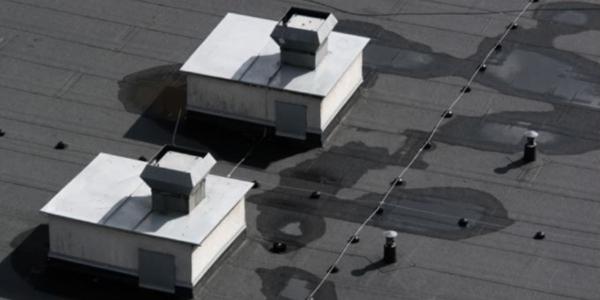Steep Slope Focus—Keeping Homeowners Informed on Winter Roofing Threats

By Thomas Schoendorf for CRCA.
Cold weather can lead to costly—and even deadly— hazards around a structure.
As a roofing contractor, you’ve probably had to repair or even replace a roof for a client after a long, harsh winter. So often, that work could have been avoided.
While it’s impossible to control the weather, homeowners can take several steps to mitigate the risks that it brings. Fortunately, you can be part of the solution by keeping homeowners educated on winter roofing risks.
The Biggest Winter Threats to Homes.
You might feel that you already know about the dangers that winter can pose for a home. But when you’re fully prepared to speak with customers about these problems and offer a solution, you establish yourself as a trustworthy resource for homeowners.
1. Snow and Ice Damage
Snow and ice are heavy, so they can possibly collapse a roof on an aging structure. When the weather gets bad, it’s easy for ice to form on the roof edges if the gutters are clogged. The gutters can become blocked when snow melts on the roof and then refreezes.
If the gutters are unable to drain away excess moisture, this can lead to an ice dam. Ice dams form when snow and ice melt upslope on a steep slope roof over heated space, then freeze when it hits the unheated area, usually at an eave. The ice dams can keep letting water flow over the gutter, creating icicles along the eaves and further weighing down the roof and gutter systems. To some, icicles may look pretty in the winter sunlight. But they spell big trouble for a roof. The extra weight from icicles can cause sagging or tear off gutters, cause water to back up under or destroy shingles, and cause leaks inside the home. Sagging ceilings and warped floors are common signs that water has seeped into the home.
Additionally, wet insulation in an attic or crawlspace can result in mold and mildew issues. An improperly insulated roof is part of the cause of ice damming and can drive up heating costs. Furthermore, icicles themselves can be dangerous if they fall and hit a person or pet.
2. Fallen Trees
All it takes is one gust of wind or a bit of snow to create big problems.Just as snow and ice can weigh down a roof, they can have the same effect on trees. And the closer those trees are to a home, the riskier they become to the house during winter. In some cases, the wind can snap off a weak tree limb, sending it to the ground or onto the roof. During a large enough storm, it’s possible for an entire tree to fall onto a structure and do serious damage—not to mention put homeowners’ lives at risk.
3. Fires
A cozy fire in the fireplace, an illuminated Christmas tree, and a glowing display of candles may sound like the perfect setting during the holidays. But those little details all represent enormous hazards if left unattended.
Blocked chimneys can result in fires. Problems with the chimney can also push smoke and carbon monoxide into a home, which can be deadly. Christmas trees can catch fire if they’re too close to a heat source or strung with lights that have worn-out electrical cords. And according to the Insurance Information Institute, December is the month with the most home fires originating from candles. No matter what season, candles should never be left unattended.
The True Costs of That Winter Storm
When these problems arise for your customers, you may need to work with an insurance carrier if the homeowners have filed a claim. If customers have questions, remind them to check their homeowners’ insurance policies to determine what is and isn’t covered.
Winter weather is the third biggest reason for all property insurance claims from catastrophic events, behind tornadoes and hurricanes. The Insurance Information Institute found that winter storms accounted for $30.4 billion in catastrophe losses between 1996 and 2015 and represented 7.5% of all claims during that period.
Research shows that the costs associated with wintertime property damage are increasing at an alarming pace. In 2015 alone, Munich Re reports that winter storms caused roughly $3.5 billion in insured losses—a $900 million increase from 2014’s losses. Prior to 2014, winter weather claims averaged roughly $1.2 billion per year, according to The New York Times, or about onethird what they cost today.
In short, winter may seem like no big deal to some of us. But a single day of extreme weather can result in hefty costs for property owners.
Spread the Knowledge
How can professional roofing contractors help homeowners this season? One way is to offer guidance at any events you attend, such as a wintertime home show. If winter is cold and snowy, you won’t be spending as much time outside this season. To continue to drive business, you might find yourself at a home show this time of year. Exhibiting at a home show enables you promote your business by meeting face to face with homeowners. You can also share your knowledge and talk to homeowners about the solutions that they need.
Some questions you might consider asking homeowners include:
- When was your last roof replacement (tear-off) or roof recover (2nd layer of roofing)?
- Have you noticed icicles along the eaves of the roof or hanging from gutters?
- Have you had any leaks in the ceiling?
- Do you regularly clean out your gutters or have someone do it for you?
Let customers know that ice dams and icicles are huge red flags for any home. Chances are you’ll receive a few calls after the show.
No plans for a home show? You don’t have to meet with customers in person to give them helpful tips and generate leads.
Have a good blog post about winter roofing issues on your website? Don’t forget to share it on your social media channels. This is great content for an email newsletter, too. If writing isn’t your forte, then try making a video. You can also link to existing articles about winter weather and home maintenance you find on social media.
Becoming a thought leader today is as easy as attending an event or updating your Facebook page. When you engage with your customers and prospects on a regular basis, they can keep you top of mind if—or when—they do need your services.
Prevention Is the Best Medicine
Above all, remind your customers and prospects that good roof maintenance is a year-round effort.
Winter is a time for professionals to work on a roof, shoveling, melting ice dams on roofs or adding insulation and maybe balancing ventilation in attic spaces. Consider using autumn to help homeowners prepare for the long winter months ahead. Gutter cleanings and repairs in the fall can help prevent the buildup of icicles in winter. This is also an ideal time to inspect insulation and discuss waterproofing measures with property owners.
Homeowners may be tempted to forget about winter roofing issues when warm weather arrives. But the springtime thaw is an especially vulnerable time for a structure. Melting snow and ice can lead to significant water damage for a roof or foundation. During the spring, mice, squirrels, bats, and insects that enter through rotted wood or a cracked foundation can do further damage to a home. A roof inspection in the spring can help homeowners avoid unpleasant surprises during the summer.
The coldest season of the year can sometimes be the most unpredictable. By maintaining the home and keeping an eye out for hazards, homeowners can avoid the worst of the winter. If something does go wrong, however, you can be there to help property owners recover.
Learn more about becoming a member of Chicago Roofing Contractors Association where you will get access to even more resources and helpful articles.
Source: CRCA























Comments
Leave a Reply
Have an account? Login to leave a comment!
Sign In